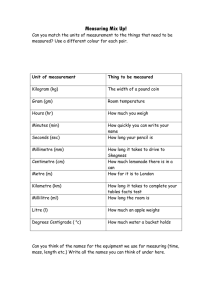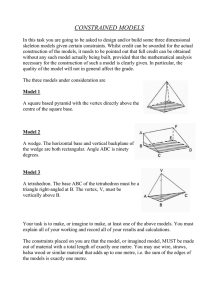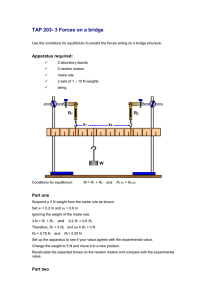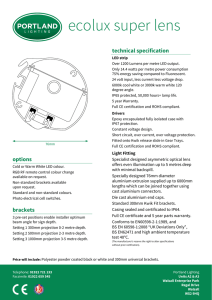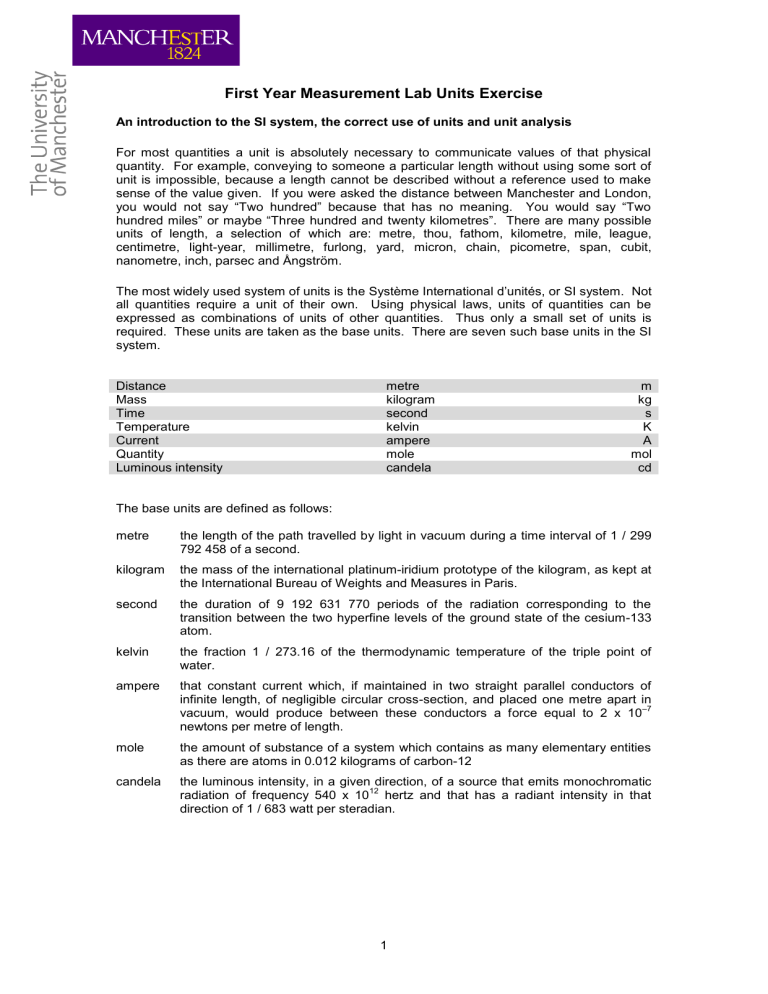
First Year Measurement Lab Units Exercise An introduction to the SI system, the correct use of units and unit analysis For most quantities a unit is absolutely necessary to communicate values of that physical quantity. For example, conveying to someone a particular length without using some sort of unit is impossible, because a length cannot be described without a reference used to make sense of the value given. If you were asked the distance between Manchester and London, you would not say “Two hundred” because that has no meaning. You would say “Two hundred miles” or maybe “Three hundred and twenty kilometres”. There are many possible units of length, a selection of which are: metre, thou, fathom, kilometre, mile, league, centimetre, light-year, millimetre, furlong, yard, micron, chain, picometre, span, cubit, nanometre, inch, parsec and Ångström. The most widely used system of units is the Système International d’unités, or SI system. Not all quantities require a unit of their own. Using physical laws, units of quantities can be expressed as combinations of units of other quantities. Thus only a small set of units is required. These units are taken as the base units. There are seven such base units in the SI system. Distance Mass Time Temperature Current Quantity Luminous intensity metre kilogram second kelvin ampere mole candela m kg s K A mol cd The base units are defined as follows: metre the length of the path travelled by light in vacuum during a time interval of 1 / 299 792 458 of a second. kilogram the mass of the international platinum-iridium prototype of the kilogram, as kept at the International Bureau of Weights and Measures in Paris. second the duration of 9 192 631 770 periods of the radiation corresponding to the transition between the two hyperfine levels of the ground state of the cesium-133 atom. kelvin the fraction 1 / 273.16 of the thermodynamic temperature of the triple point of water. ampere that constant current which, if maintained in two straight parallel conductors of infinite length, of negligible circular cross-section, and placed one metre apart in –7 vacuum, would produce between these conductors a force equal to 2 x 10 newtons per metre of length. mole the amount of substance of a system which contains as many elementary entities as there are atoms in 0.012 kilograms of carbon-12 candela the luminous intensity, in a given direction, of a source that emits monochromatic 12 radiation of frequency 540 x 10 hertz and that has a radiant intensity in that direction of 1 / 683 watt per steradian. 1 All other units may be derived from these base units. Force Energy Power Frequency Pressure Electric charge Electrical resistance Electrical capacitance Electrical potential difference Electrical conductance Magnetic flux Magnetic flux density Inductance Radioactivity Area Volume Velocity Acceleration Wavenumber Density Current density Concentration Luminance Dynamic viscosity Moment of force Surface tension Angular velocity Angular acceleration Irradiance Entropy Specific energy Specific heat capacity Permittivity Permeability newton joule watt hertz pascal coulomb ohm farad volt siemens weber tesla henry becquerel square metre metre cubed metre per second metre per second squared per metre kilogram per metre cubed ampere per metre squared mole per metre cubed candela per metre squared pascal second newton metre newton per metre radian per second radian per second squared watt per metre squared joule per kelvin joule per kilogram joule per kilogram kelvin farad per metre henry per metre N J W Hz Pa C F V S Wb T H Bq 2 m 3 m –1 ms –2 ms –1 m –3 kg m –2 Am –3 mol m –2 cd m Pa s Nm –1 Nm –1 rad s –2 rad s –2 Wm –1 JK –1 J kg –1 –1 J kg K –1 Fm –1 Hm –2 kg m s 2 –2 kg m s 2 –3 kg m s –1 s –1 –2 kg m s As 2 –3 –2 kg m s A –1 –2 4 2 kg m s A 2 –3 –1 kg m s A –1 –2 3 2 kg m s A 2 –2 –1 kg m s A –2 –1 kg s A 2 –2 –2 kg m s A –1 s 2 m 3 m –1 ms –2 ms –1 m –3 kg m –2 Am –3 mol m –2 cd m –1 –1 kg m s 2 –2 kg m s –2 kg s –1 rad s –2 rad s –3 kg s 2 –2 –1 kg m s K 2 –2 m s 2 –2 –1 m s K –1 –3 4 2 kg m s A –2 –2 kg m s A N.B. Some units are named after famous scientists. In such cases both the name of the scientist and the symbol of the unit are capitalised however the name of the unit is NOT capitalised. So for example, the newton, symbol N, was named after Sir Isaac Newton. Also please note that units are never italicised and are written with a space between the value and the unit and between each part of a compound unit. This prevents ambiguity between, for –1 –1 –1 –1 example, a metre per second m s and per millisecond ms . For example, 8.314 J K mol is correct. Units are never pluralised as this might be confused with seconds. So 30 min is correct and 30 mins is incorrect. 2 The SI system currently uses twenty prefixes to denote multiples and submultiples of SI units. It is important to note that the kilogram is the only SI unit with a prefix as part of its name and symbol. Because multiple prefixes are not allowed, in the case of the kilogram the prefix names shown below are used with the unit name, gram, and the prefix symbols are used with the unit symbol, g. 24 10 21 10 18 10 15 10 12 10 9 10 6 10 3 10 2 10 1 10 yotta zetta exa peta tera giga mega kilo hecto deka –1 Y Z E P T G M k h da 10 –2 10 –3 10 –6 10 –9 10 –12 10 –15 10 –18 10 –21 10 –24 10 deci centi milli micro nano pico femto atto zepto yocto d c m µ n p f a z y The following are some useful physical formulae for deconstructing units into their base SI units. F=ma force = mass × acceleration W=Fd work = force × distance moved in the direction of the force Ep = m g h Ek = ½ m v gravitational potential energy = mass × acceleration due to gravity × height 2 kinetic energy = half × mass × velocity squared P=W/t power = work per unit time P=VI power = voltage × current V=IR voltage = current × resistance 2 P=I R power loss = current squared × resistance p=F/A pressure = force per unit area A WORD CONCERNING THE EXERCISES The first skill you need to develop is the ability to break any compound unit down into its constituent basic SI units, this is covered in exercise 1. This is typically done with a working knowledge of basic formulae from physics GCSE and A level. Exercise two demonstrates that any correct, relevant formula from physics will suffice as the result will always be the same. Exercise three is designed to demonstrate that units are always equivalent across equations. The equals sign governs the units in exactly the same way as the terms in the equation. The last part of exercise three is extremely involved and you will need to work methodically and with great care in order to prove the equivalence of the units. It serves however to show that the equivalence of units is independent of the complexity of the equation. Exercise four highlights that constants sometimes have units and that these units need to be considered carefully – the example chosen is taken from chemical kinetics. Finally, exercise five is designed to illustrate the benefit to you of becoming a skilled manipulator of units. Imagine in an examination you cannot quite remember an equation. Maybe you can remember all the terms. but cannot remember whether they go on the top or the bottom. or maybe you can remember all the terms but one. You can use the equivalence of units in equations to work out the missing quantity or to decide whether an equation as written is sensible. Remember, if the units are not equivalent then the equation is wrong. 3 EXERCISES 1. Show, with working, the derivation of the following units, given on page two, in terms of the seven base SI units: N J W Pa V 4 2. Starting with your example from exercise one, show that the definitions of work, gravitational potential energy and kinetic energy, given on page three, ALL lead to exactly the same derivation of the joule in terms of the seven base SI units. 5 3. Show the equivalence of the units on either side of the following equations: pV=nRT (pressure × volume = number of moles × ideal gas constant × temperature) G = H – TS (change in molar Gibbs energy = change in molar enthalpy – temperature × change in molar entropy) G = –R T ln k (change in molar Gibbs energy = – ideal gas constant × temperature × natural log of the equilibrium constant) = c R T (osmotic pressure = concentration difference × ideal gas constant × temperature) 6 1 2c k ( = wavenumber which has units of m , c = speed of light in vacuo, k = bond –1 force constant which has units of N m units of kg) –1 and = bond reduced mass which has p = h g E (pressure difference = height × fluid density × acceleration due to gravity) me e 4 8 02 n 2 h 2 (E = energy, me = mass of the electron, e = charge on the electron, 0 = permittivity constant, n = quantum number, h = Plank constant which has units of J s) 7 4. For a reaction in which A reacts to give products, the zero, first and second order rate equations may be written as follows where [ ] denotes concentration. In each case the differential represents the rate of change of the concentration of reactant A with time and k is termed the rate constant or velocity constant. d[ A ] k dt d[ A ] k [A] dt d[ A ] k [A] 2 dt From consideration of the units of the quantities of the above equations, determine the units for the rate constant in each case and show that these differ as the order of reaction changes. 8 5. Use the equivalence of units on either side of an equation to determine the missing symbol in the following equation for the measurement of the surface tension of a fluid via the capilliary rise method. rg ? h 2 cos ( = surface tension of the fluid, r = radius of the capilliary, g = acceleration due to gravity, ? = to be determined, h = height of the liquid rise, = contact angle) Dr Jonathan Agger 2007 [last modified 2013] 9

